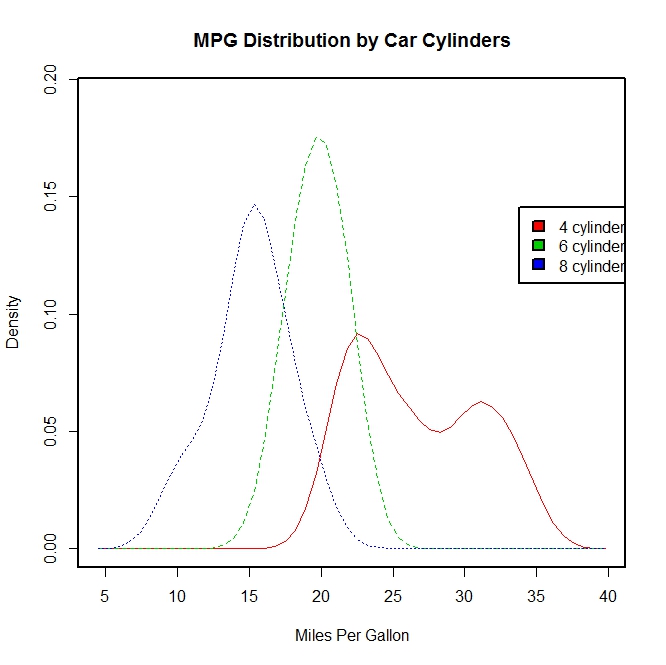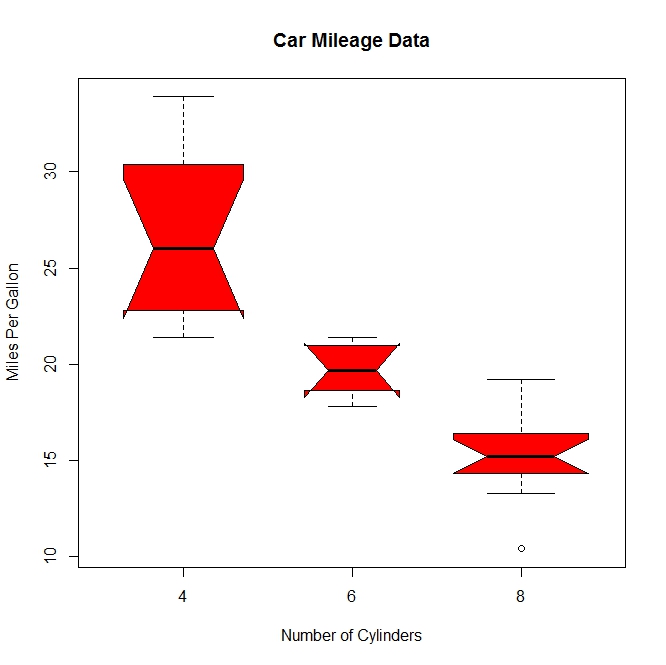R语言实战读书笔记(六)基本图形
#安装vcd包,数据集在vcd包中
library(vcd)
counts <- table(Arthritis$Improved)
counts
# 垂直
barplot(counts, main = "Simple Bar Plot", xlab = "Improvement",
ylab = "Frequency")
# 改为水平
barplot(counts, main = "Horizontal Bar Plot", xlab = "Frequency",
ylab = "Improvement", horiz = TRUE)
# 两个列
counts <- table(Arthritis$Improved, Arthritis$Treatment)
counts
# 堆砌条形图
barplot(counts, main = "Stacked Bar Plot", xlab = "Treatment",
ylab = "Frequency", col = c("red", "yellow", "green"),
legend = rownames(counts))

#分组条形图
barplot(counts, main = "Grouped Bar Plot", xlab = "Treatment",
ylab = "Frequency", col = c("red", "yellow", "green"),
legend = rownames(counts),
beside = TRUE)

states <- data.frame(state.region, state.x77)
means <- aggregate(states$Illiteracy, by = list(state.region), FUN = mean)
means
means <- means[order(means$x), ]
means
barplot(means$x, names.arg = means$Group.1)
title("Mean Illiteracy Rate")

library(vcd)
attach(Arthritis)
counts <- table(Treatment, Improved)
#棘状图
spine(counts, main = "Spinogram Example")
detach(Arthritis)

#屏幕分成2行2列,可以放4副图
par(mfrow = c(2, 2))
#图1中的数据
slices <- c(10, 12, 4, 16, 8)
#图1中的文字
lbls <- c("US", "UK", "Australia", "Germany", "France")
#饼图1
pie(slices, labels = lbls, main = "Simple Pie Chart")
#图2中的数据,是图1中数据的百分比
pct <- round(slices/sum(slices) * 100)
lbls2 <- paste(lbls, " ", pct, "%", sep = "")
pie(slices, labels = lbls2, col = rainbow(length(lbls)), main = "Pie Chart with Percentages")
#三维饼图
library(plotrix)
pie3D(slices, labels = lbls, explode = 0.1, main = "3D Pie Chart ")
#
mytable <- table(state.region)
lbls <- paste(names(mytable), "\n", mytable, sep = "")
pie(mytable, labels = lbls, main = "Pie Chart from a Table\n (with sample sizes)")

#扇形图
par(opar)
library(plotrix)
slices <- c(10, 12, 4, 16, 8)
lbls <- c("US", "UK", "Australia", "Germany", "France")
fan.plot(slices, labels = lbls, main = "Fan Plot")

#直方图
#2行2列
par(mfrow = c(2, 2))
#普通的直方图
hist(mtcars$mpg)
#指定12组
hist(mtcars$mpg, breaks = 12, col = "red",xlab = "Miles Per Gallon", main = "Colored histogram with 12 bins")
#freq=FALSE表示密度直方图
hist(mtcars$mpg, freq = FALSE, breaks = 12, col = "red", xlab = "Miles Per Gallon", main = "Histogram, rug plot, density curve")
#jitter是添加一些噪声,rug是在坐标轴上标出元素出现的频数。出现一次,就会画一个小竖杠。从rug的疏密可以看出变量是什么地方出现的次数多,什么地方出现的次数少。
#轴须图是实际数据值的一种一维呈现方式。如果数据中有很多结(相同的值),可以使用如下代码将数据打散布,会向每个数据点添加一个小的随机值,以避免重叠点产生的影响。
rug(jitter(mtcars$mpg))
#画密度线
lines(density(mtcars$mpg), col = "blue", lwd = 2)
# Histogram with Superimposed Normal Curve
x <- mtcars$mpg
h <- hist(x, breaks = 12, col = "red", xlab = "Miles Per Gallon", main = "Histogram with normal curve and box")
xfit <- seq(min(x), max(x), length = 40)
#正态分布
yfit <- dnorm(xfit, mean = mean(x), sd = sd(x))
yfit <- yfit * diff(h$mids[1:2]) * length(x)
lines(xfit, yfit, col = "blue", lwd = 2)
#添加一个框
box()

par(mfrow = c(2, 1))
d <- density(mtcars$mpg)
plot(d)
d <- density(mtcars$mpg)
plot(d, main = "Kernel Density of Miles Per Gallon")
#画多边形
polygon(d, col = "red", border = "blue")
#添加棕色轴须图
rug(mtcars$mpg, col = "brown")

#双倍线宽
par(lwd = 2)
library(sm)
attach(mtcars)
#产生一个因子cyl.f,cyl是mtcars的一个列
cyl.f <- factor(cyl, levels = c(4, 6, 8),labels = c("4 cylinder", "6 cylinder", "8 cylinder"))
sm.density.compare(mpg, cyl, xlab = "Miles Per Gallon")
title(main = "MPG Distribution by Car Cylinders")
#指定颜色值
colfill <- c(2:(2 + length(levels(cyl.f))))
cat("Use mouse to place legend...", "\n\n")
#locator表示在鼠标点击的位置上添加图例
legend(locator(1), levels(cyl.f), fill = colfill)
detach(mtcars)
par(lwd = 1)

boxplot(mpg ~ cyl, data = mtcars, main = "Car Milage Data", xlab = "Number of Cylinders", ylab = "Miles Per Gallon")

#notch=TRUE含凹槽的箱线图,有凹槽不重叠,表示中位数有显著差异,如下图,都有明显差异,
boxplot(mpg ~ cyl, data = mtcars, notch = TRUE, varwidth = TRUE, col = "red", main = "Car Mileage Data", xlab = "Number of Cylinders", ylab = "Miles Per Gallon")

mtcars$cyl.f <- factor(mtcars$cyl, levels = c(4, 6, 8), labels = c("4", "6", "8"))
mtcars$am.f <- factor(mtcars$am, levels = c(0, 1), labels = c("auto", "standard"))
boxplot(mpg ~ am.f * cyl.f, data = mtcars, varwidth = TRUE, col = c("gold", "darkgreen"), main = "MPG Distribution by Auto Type", xlab = "Auto Type")
#如下图,再一次清晰显示油耗随着缸数下降而减少,对于四和六缸,标准变速箱的油耗更高。对于八缸车型,油耗似乎没有差别
#也可以从箱线图的宽度看出,四缸标准变速成箱的车型和八缸自动变速箱的车型在数据集中最常见

dotchart(mtcars$mpg, labels = row.names(mtcars), cex = 0.7, main = "Gas Milage for Car Models", xlab = "Miles Per Gallon")

x <- mtcars[order(mtcars$mpg), ]
x$cyl <- factor(x$cyl)
x$color[x$cyl == 4] <- "red"
x$color[x$cyl == 6] <- "blue"
x$color[x$cyl == 8] <- "darkgreen"
dotchart(x$mpg, labels = row.names(x), cex = 0.7,
pch = 19, groups = x$cyl,
gcolor = "black", color = x$color,
main = "Gas Milage for Car Models\ngrouped by cylinder",
xlab = "Miles Per Gallon")

R语言实战读书笔记(六)基本图形的更多相关文章
- R语言实战读书笔记(三)图形初阶
这篇简直是白写了,写到后面发现ggplot明显更好用 3.1 使用图形 attach(mtcars)plot(wt, mpg) #x轴wt,y轴pgabline(lm(mpg ~ wt)) #画线拟合 ...
- R语言实战读书笔记(二)创建数据集
2.2.2 矩阵 matrix(vector,nrow,ncol,byrow,dimnames,char_vector_rownames,char_vector_colnames) 其中: byrow ...
- R语言实战读书笔记1—语言介绍
第一章 语言介绍 1.1 典型的数据分析步骤 1.2 获取帮助 help.start() help("which") help.search("which") ...
- R语言实战读书笔记(八)回归
简单线性:用一个量化验的解释变量预测一个量化的响应变量 多项式:用一个量化的解决变量预测一个量化的响应变量,模型的关系是n阶多项式 多元线性:用两个或多个量化的解释变量预测一个量化的响应变量 多变量: ...
- R语言实战读书笔记2—创建数据集(上)
第二章 创建数据集 2.1 数据集的概念 不同的行业对于数据集的行和列叫法不同.统计学家称它们为观测(observation)和变量(variable) ,数据库分析师则称其为记录(record)和字 ...
- R语言实战读书笔记(五)高级数据管理
5.2.1 数据函数 abs: sqrt: ceiling:求不小于x的最小整数 floor:求不大于x的最大整数 trunc:向0的方向截取x中的整数部分 round:将x舍入为指定位的小数 sig ...
- R语言实战读书笔记(四)基本数据管理
4.2 创建新变量 几个运算符: ^或**:求幂 x%%y:求余 x%/%y:整数除 4.3 变量的重编码 with(): within():可以修改数据框 4.4 变量重命名 包reshape中有个 ...
- R语言实战读书笔记(一)R语言介绍
1.3.3 工作空间 getwd():显示当前工作目录 setwd():设置当前工作目录 ls():列出当前工作空间中的对象 rm():删除对象 1.3.4 输入与输出 source():执行脚本
- R语言实战读书笔记(十三)广义线性模型
# 婚外情数据集 data(Affairs, package = "AER") summary(Affairs) table(Affairs$affairs) # 用二值变量,是或 ...
随机推荐
- java的一些相关介绍(2013-10-07-163 写的日志迁移
java是一种可以撰写跨平台应用软件的面向对象的程序设计语言,是由Sun Microsystems公司于1995年5月推出的Java程序设计语言和Java平台(即JavaSE, JavaEE, Jav ...
- Python头脑风暴1
发个致富脑洞:我就在想本人虽然单身,但本人恋爱经历很多,追女生技术十足,女朋友漂亮又贤惠.如果本人开个平台帮人诚心介绍女朋友,男女成男女朋友经男方同意我收2.5万(IT界平均月收入的1.5倍不到),双 ...
- STM32CUBEMX入门学习笔记3:HAL库以及STM32CUBE相关资料
微雪课堂:http://www.waveshare.net/study/article-629-1.html 之前的正点原子的例程资料 硬石科技stm32cube: 链接:https://pan.ba ...
- jenkins匿名用户登录 - 安全设置
最近自己安装配置jenkins,但是跑任务时,发现是匿名账户登录,且提示: 后来发现搭建好jenkins之后,默认就是匿名用户登录的,可以在安装设置菜单里进行账户管理. 1.登录Jenkins服务器, ...
- HDU 4605 Magic Ball Game 主席树
题意: 给一棵\(n(1 \leq n \leq 10^5)\)个节点的二叉树,除叶子节点外,每个点都有左儿子和右儿子. 每个点上都有一个权值. 游戏规则是这样的:在根节点放一个权值为\(X\)的小球 ...
- HDU 4812 D Tree 树分治
题意: 给出一棵树,每个节点上有个权值.要找到一对字典序最小的点对\((u, v)(u < v)\),使得路径\(u \to v\)上所有节点权值的乘积模\(10^6 + 3\)的值为\(k\) ...
- POJ-3278 广度优先搜索入门
#include<stdio.h> #include<stdlib.h> struct node{ int x; int s; }s[]; int main(){ ]={}; ...
- Hive中集合类型
Hive中集合类型 创建表,集合是以 - 分割的 数据文件 加载数据 查询数据 查询数组中第一个字段 再建一个表,使用map 查看数据文件 加载数据 查询数据 查询键值 创建表,struct类型 查看 ...
- Vue简单了解
目录 1. 前端概览 2. 现代前端开发方式 3. MVVM开发核心 4. Vue核心 5. Vue优点 6. Vue难点 7. Vue与非Vue项目结合 8. Vue调试 9. Vue与SEO 今天 ...
- day04_02 知识回顾、赋值运算符
input命令输出的是字符串 数字转换成字符串 字符串转换成数字 以上成为类型的强制转换 运算符
